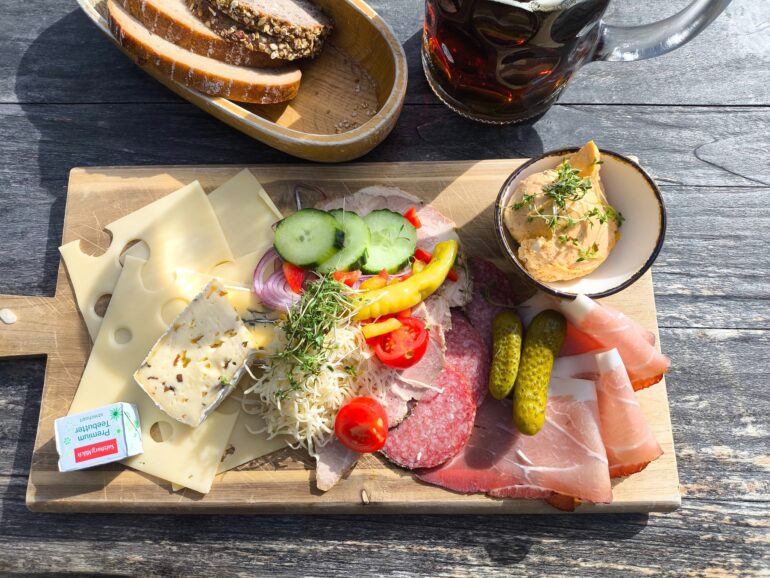| Location: | Jenneralm |
| Website: | https://www.jennerbahn.de/kulinarik/#Jenneralm |
| Address: | Jennerbahnstraße 18, 83471 Schönau am Königssee, Germany |
| Status: | Open (last checked on 10 October 2025) |
| Eaten: | "Bayerischer Brotzeitteller," one liter beer (Hofbrauhaus Berchtesgaden Dunkel) |
During my travels, I have passed through Germany multiple times (most frequently, through the Deutsches Eck, which connects Salzburg with Tirol), but I have not spent a night there since the short family holidays in Bad Tölz, when I was 18 and knew nothing about Brettljausen and Martinigänse. However, the lake Königsee had long been on my list of places to visit, and finally I managed to arrange a long weekend in Schönau, with the weather (mostly) cooperating. In fact, this was the final weekend when the boats on the lake went all the way to the other end of it, rather than terminating halfway at Bartholomä.
So late in the autumn, the mountain of Jenner, which is, after the lake, the town’s main attraction, met me with a mix of clouds, sun and thick fog. With no guarantee that huts along the circular hiking path on the summit were open, I decided not to take risks and have my lunch at the restaurant next to the cable car’s top station. A monstrous construction out of glass and concrete, Jenneralm is, honestly, not very inviting – and the views from its terrace are less than spectacular unless one sits (or, better, stands) right by the railings – but it introduced me to my first German Brettljause in all in all a positive way.
As I have known from my holidays in the Austrian regions close to the German border, Germans do not use the word Brettljause, but call the cold cuts platter Brotzeit (literally, “bread time”) instead. If you want my opinion, it is a very silly word, even if you realize that a Jause means nothing else but a snack. Most Brettljausen are very far from simple snacks, of course, usually being complete and quite heavy dishes. Considering Germans’ love for huge portions at the expense of refined taste, I was not surprised to find my Brotzeitteller impressively big, but was quite surprised to like it.
Here are the main differences from Austrian Jausen, as far as I have noticed. First and foremost, the Obatzda, sometimes called Obazda or Obatzter. Basically, it’s the Bavarian version of Liptauer (sharing more or less the same color), but while a Liptauer can be quite light, an Obatzda is thick and very filling, more of a soft cheese than a spread. The Obatzda on my Brotzeitteller was slightly spicy and generally enjoyable, especially when mixed with strong horseradish and onions. It is easy to see why it is the most popular accompaniment to beer in this region.
Three other types of cheese were included, a strong blue cheese among them. While the cold Schweinsbraten and the salami were totally edible but not special, the Speck was far too salty for my liking. It was heartwarming to find a piece of Austria in the dish in the form of a small portion of wrapped tea butter from Salzburg, even taking into account that the border with the Salzburgerland was a mere kilometer away. Another observation was that for Bavarians, a “small beer” often means a half a liter, while a “large beer” is a Mass, that is one liter. Since I rarely drink fewer than two mugs, having a Mass straight away was actually timesaving.
Despite the name, the “bread time” of Jenneralm seriously lacked bread. The four smallish slices provided were barely sufficient for the cheeses, forcing me to spread the cheese as thickly as possible. Nevertheless, apart from that and the oversalted Speck, my very first German Brettljause left a favorable impression.


